Applications of Optical Coherence Tomography in the Diagnosis of Enamel Defects
Abstract
:1. Introduction
2. Materials and Methods
3. Results
4. Discussion
5. Conclusions
Author Contributions
Funding
Institutional Review Board Statement
Informed Consent Statement
Data Availability Statement
Conflicts of Interest
References
- Seymen, F.; Zhang, H.; Kasimoglu, Y.; Koruyucu, M.; Simmer, J.P.; Hu, J.C.; Kim, J.W. Novel Mutations in GPR68 and SLC24A4 Cause Hypomaturation Amelogenesis Imperfecta. J. Pers. Med. 2021, 12, 13. [Google Scholar] [CrossRef] [PubMed]
- Huang, W.; Zhang, X.; Yang, M.; Li, R.; Song, Y. PER2-mediated ameloblast differentiation via PPARγ/AKT1/β-catenin axis. Int. J. Oral Sci. 2021, 13, 16. [Google Scholar] [CrossRef] [PubMed]
- Hillson, S.; Bond, S. Relationship of enamel hypoplasia to the pattern of tooth crown growth: A discussion. Am. J. Phys. Anthr. 1997, 101, 89–103. [Google Scholar] [CrossRef]
- Sabel, N.; Klingberg, G.; Dietz, W.; Nietzsche, S.; Noren, J.G. Polarized light and scanning electron microscopic investigation of enamel hypoplasia in primary teeth. Int. J. Paediatr. Dent. 2010, 20, 31–36. [Google Scholar] [CrossRef] [Green Version]
- Malik, Z.; Roth, D.M.; Eaton, F.; Theodor, J.M.; Graf, D. Mesenchymal Bmp7 Controls Onset of Tooth Mineralization: A Novel Way to Regulate Molar Cusp Shape. Front. Physiol. 2020, 11, 698. [Google Scholar] [CrossRef] [PubMed]
- Schraverus, M.S.; Olegário, I.C.; Bonifácio, C.C.; González, A.P.R.; Pedroza, M.; Hesse, D. Glass Ionomer Sealants Can Prevent Dental Caries but Cannot Prevent Posteruptive Breakdown on Molars Affected by Molar Incisor Hypomineralization: One-Year Results of a Randomized Clinical Trial. Caries Res. 2021, 55, 301–309. [Google Scholar] [CrossRef] [PubMed]
- Pawlaczyk-Kamieńska, T.; Winiarska, H.; Kulczyk, T.; Cofta, S. Dental Anomalies in Rare, Genetic Ciliopathic Disorder—A Case Report and Review of Literature. Int. J. Environ. Res. Public Health 2020, 17, 4337. [Google Scholar] [CrossRef]
- Onyejaka, N.K.; Amobi, E.O.; Olatosi, O.O. Sociodemographic and behavioral factors associated with developmental dental hard-tissue anomalies in children with primary dentition. Indian J. Dent. Sci. 2020, 12, 121–125. [Google Scholar]
- Popescu, M.; Mercuț, V.; Ionescu, M.; Petrescu, S.M.S.; Cenușoiu, A.; Stănuși, A.; Bătăiosu, M. Epidemiological study of acquired developmental defects of enamel in children between 3 and 19 years old from Dolj county, Romania. RJOR 2020, 12, 137–144. [Google Scholar]
- Reed, S.G.; Miller, C.S.; Wagner, C.L.; Hollis, B.W.; Lawson, A.B. Toward Preventing Enamel Hypoplasia: Modeling Maternal and Neonatal Biomarkers of Human Calcium Homeostasis. Caries Res. 2020, 54, 55–67. [Google Scholar] [CrossRef]
- Andrade, N.S.; Dos Santos, I.T.; Lima, L.M.S.; Lima, C.C.B.; Moura, L.F.A.D.; Barros, S.S.L.V.; Moura, M.S.; Lima, M.D.M. Impact of Developmental enamel defects on quality of life in 5-year-old children. Int. J. Paediatr. Dent. 2019, 29, 557–565. [Google Scholar] [CrossRef] [PubMed]
- Lygidakis, N.A.; Garot, E.; Somani, C.; Taylor, G.D.; Rouas, P.; Wong, F.S.L. Best clinical practice guidance for clinicians dealing with children presenting with molar-incisor-hypomineralisation (MIH): An updated European Academy of Paediatric Dentistry policy document. Eur. Arch. Paediatr. Dent. 2021. Epub ahead of print. [Google Scholar] [CrossRef] [PubMed]
- Faustino-Silva, D.D.; Rocha, A.F.; da Rocha, B.S.; Stein, C. Use of Antibiotics in early Childhood and Dental Enamel Defects in 6- to 12-year-old Children in Primary Health Care. Acta Odontol. Latinoam. 2020, 33, 6–13. [Google Scholar] [CrossRef] [PubMed]
- Feltrin-Souza, J.; Costa, S.A.D.; Bussaneli, D.G.; Santos-Pinto, L.; Cerri, P.S.; Cury, J.; Tenuta, L.; Cordeiro, R.D. In vivo effect of fluoride combined with amoxicillin on enamel development in rats. J. Appl. Oral Sci. 2021, 29, e20210171. [Google Scholar] [CrossRef] [PubMed]
- Mohamed, R.N.; Basha, S.; Al-Thomali, Y.; Al Zahrani, F.S.; Ashour, A.A.; Al Shamrani, A.S.; Almutair, N.E. Frequency of molar incisor hypomineralization and associated factors among children with special health care needs. Ann. Saudi Med. 2021, 41, 238–245. [Google Scholar] [CrossRef]
- Simratvir, M. Extensive Hypoplasia of Permanent Dentition Due to Childhood Illness and Antibiotic Use—A Case Report. Dentistry 2011, 1, 107. [Google Scholar] [CrossRef] [Green Version]
- Giuca, M.R.; Cappè, M.; Carli, E.; Lardani, L.; Pasini, M. Investigation of Clinical Characteristics and Etiological Factors in Children with Molar Incisor Hypomineralization. Int. J. Dent. 2018, 2018, 7584736. [Google Scholar] [CrossRef]
- Wogelius, P.; Viuff, J.H.; Haubek, D. Use of asthma drugs and prevalence of molar incisor hypomineralization. Int. J. Paediatr. Dent. 2020, 30, 734–740. [Google Scholar] [CrossRef] [Green Version]
- Serna Muñoz, C.; Ortiz Ruiz, A.J.; Pérez Silva, A.; Bravo-González, L.A.; Vicente, A. Second primary molar hypomineralisation and drugs used during pregnancy and infancy. A systematic review. Clin. Oral Investig. 2020, 24, 1287–1297. [Google Scholar] [CrossRef]
- Serna Muñoz, C.; Pérez Silva, A.; Solano, F.; Castells, M.T.; Vicente, A.; Ortiz Ruiz, A.J. Effect of antibiotics and NSAIDs on cyclooxygenase-2 in the enamel mineralization. Sci. Rep. 2018, 8, 4132. [Google Scholar] [CrossRef]
- Kameli, S.; Moradi-Kor, N.; Tafaroji, R.; Ghorbani, R.; Farzadmnesh, H.; Sameni, H. Effects of Amoxicillin on the Structure and Mineralization of Dental Enamel and Dentin in Wistar Rats. Front. Dent. 2019, 16, 130–135. [Google Scholar] [CrossRef]
- Gottberg, B.; Berné, J.; Quiñónez, B.; Solórzano, E. Prenatal effects by exposing to amoxicillin on dental enamel in Wistar rats. Med. Oral Patol. Oral Cir Bucal. 2014, 19, e38–e43. [Google Scholar] [CrossRef]
- Machoy, M.E.; Koprowski, R.; Szyszka-Sommerfeld, L.; Safranow, K.; Gedrange, T.; Woźniak, K. Optical coherence tomography as a non-invasive method of enamel thickness diagnosis after orthodontic treatment by 3 different types of brackets. Adv. Clin. Exp. Med. 2019, 28, 211–218. [Google Scholar] [CrossRef] [PubMed]
- Kazoullis, S.; Seow, W.K.; Holcombe, T.; Newman, B.; Ford, D. Common dental conditions associated with dental erosion in schoolchildren in Australia. Pediatr. Dent. 2007, 29, 33–39. [Google Scholar]
- Torlińska-Walkowiak, N.; Majewska, K.A.; Kędzia, A.; Opydo-Szymaczek, J. Clinical Implications of Growth Hormone Deficiency for Oral Health in Children: A Systematic Review. J. Clin. Med. 2021, 10, 3733. [Google Scholar] [CrossRef]
- Chen, C.F.; Hu, J.C.; Bresciani, E.; Peters, M.C.; Estrella, M.R. Treatment considerations for patient with Amelogenesis Imperfecta: A review. Braz. Dent. Sci. 2013, 16, 7–18. [Google Scholar] [CrossRef]
- Kindelan, S.A.; Day, P.; Nichol, R.; Willmott, N.; Fayle, S.A.; British Society of Paediatric Dentistry. UK National Clinical Guidelines in Paediatric Dentistry: Stainless steel preformed crowns for primary molars. Int. J. Paediatr. Dent. 2008, 18, 20–28. [Google Scholar] [CrossRef]
- Machoy, M.; Seeliger, J.; Szyszka-Sommerfeld, L.; Koprowski, R.; Gedrange, T.; Woźniak, K. The Use of Optical Coherence Tomography in Dental Diagnostics: A State-of-the-Art Review. J. Healthc. Eng. 2017, 2017, 7560645. [Google Scholar] [CrossRef] [Green Version]
- Al-Azri, K.; Melita, L.N.; Strange, A.P.; Festy, F.; Al-Jawad, M.; Cook, R.; Parekh, S.; Bozec, L. Optical coherence tomography use in the diagnosis of enamel defects. J. Biomed. Opt. 2016, 21, 36004. [Google Scholar] [CrossRef] [PubMed] [Green Version]
- Shimada, Y.; Yoshiyama, M.; Tagami, J.; Sumi, Y. Evaluation of dental caries, tooth crack, and age-related changes in tooth structure using optical coherence tomography. Jpn. Dent. Sci. Rev. 2020, 56, 109–118. [Google Scholar] [CrossRef] [PubMed]
- Fercher, A.; Hitzenberger, C. Optical coherence tomography. In Progress in Optics; Visser, T., Ed.; Academic Press: Cambridge, MA, USA, 2002; Volume 67, pp. 215–302. [Google Scholar]
- Kashiwa, M.; Shimada, Y.; Sadr, A.; Yoshiyama, M.; Sumi, Y.; Tagami, J. Diagnosis of Occlusal Tooth Wear Using 3D Imaging of Optical Coherence Tomography Ex Vivo. Sensors 2020, 20, 6016. [Google Scholar] [CrossRef] [PubMed]
- Colston Jr, B.W.; Everett, M.J.; Da Silva, L.B.; Otis, L.L.; Stroeve, P.; Nathel, H. Imaging of hard and soft tissue structure in the oral cavity by optical coherence tomography. Appl. Opt. 1998, 37, 3582–3585. [Google Scholar] [CrossRef] [PubMed]
- Jones, R.S.; Fried, D. Remineralization of enamel caries can decrease optical reflectivity. J. Dent. Res. 2006, 85, 804–808. [Google Scholar] [CrossRef] [PubMed] [Green Version]
- Zeng, S.; Huang, Y.; Huang, W.; Pathak, J.L.; He, Y.; Gao, W.; Huang, J.; Zhang, Y.; Zhang, J.; Dong, H. Real-Time Monitoring and Quantitative Evaluation of Resin In-Filtrant Repairing Enamel White Spot Lesions Based on Optical Coherence Tomography. Diagnostics 2021, 11, 2046. [Google Scholar] [CrossRef]
- Petrescu, S.M.; Țuculină, M.J.; Osiac, E.; Camen, A.; Sălan, A.I.; Mărășescu, F.I.; Nicola, A.G.; Bechir, E.S.; Dascălu, I.T. Use of optical coherence tomography in orthodontics. Exp. Ther. Med. 2021, 22, 1424. [Google Scholar] [CrossRef]
- Hsieh, Y.S.; Ho, Y.C.; Lee, S.Y.; Chuang, C.C.; Tsai, J.C.; Lin, K.F.; Sun, C.W. Dental optical coherence tomography. Sensors 2013, 13, 8928–8949. [Google Scholar] [CrossRef] [Green Version]
- Chiriac, A.M.; Mercuț, V.; Popescu, S.M.; Osiac, E.; Bătăiosu, M. The OCT analysis of primary teeth affected by tooth wear. RJOR 2020, 12, 165–175. [Google Scholar]
- Mercuț, V.; Popescu, S.M.; Scrieciu, M.; Amărăscu, M.O.; Vătu, M.; Diaconu, O.A.; Osiac, E.; Ghelase, Ş.M. Optical coherence tomography applications in tooth wear diagnosis. Rom. J. Morphol. Embryol. 2017, 58, 99–106. [Google Scholar]
- Manesh, S.K.; Darling, C.L.; Fried, D. Polarization-sensitive optical coherence tomography for the nondestructive assessment of the remineralization of dentin. J. Biomed. Opt. 2009, 14, 044002. [Google Scholar] [CrossRef]
- Otis, L.L.; Everett, M.J.; Sathyam, U.S.; Colston, B.W., Jr. Optical coherence tomography: A new imaging technology for dentistry. J. Am. Dent. Assoc. 2000, 131, 511–514. [Google Scholar] [CrossRef] [PubMed]
- Hariri, I.; Sadr, A.; Nakashima, S.; Shimada, Y.; Tagami, J.; Sumi, Y. Estimation of the enamel and dentin mineral content from the refractive index. Caries. Res. 2013, 47, 18–26. [Google Scholar] [CrossRef] [PubMed]
- Natsume, Y.; Nakashima, S.; Sadr, A.; Shimada, Y.; Tagami, J.; Sumi, Y. Estimation of lesion progress in artificial root caries by swept source optical coherence tomography in comparison to transverse microradiography. J. Biomed. Opt. 2011, 16, 071408. [Google Scholar] [CrossRef] [PubMed]
- Ali, S.; Gilani, S.B.S.; Shabbir, J.; Almulhim, K.S.; Bugshan, A.; Farooq, I. Optical coherence tomography’s current clinical medical and dental applications: A review. F1000 Res. 2021, 10, 310. [Google Scholar] [CrossRef]
- Hirasuna, K.; Fried, D.; Darling, C.L. Near-infrared imaging of developmental defects in dental enamel. J. Biomed. Opt. 2008, 13, 044011. [Google Scholar] [CrossRef] [PubMed]
- Amaechi, B.T.; Podoleanu, A.G.; Komarov, G.; Higham, S.M.; Jackson, D.A. Quantification of root caries using optical coher-ence tomography and microradiography: A correlational study. Oral Health Prev. Dent. 2004, 2, 377–382. [Google Scholar]
- Heck, K.; Litzenburger, F.; Geitl, T.; Kunzelmann, K.H. Near-infrared reflection at 780 nm for detection of early proximal caries in posterior permanent teeth in vitro. Dentomaxillofac. Radiol. 2021, 50, 20210005. [Google Scholar] [CrossRef]
- Yang, V.B.; Chang, N.Y.; Fried, D. A thermal imaging handpiece for the clinical assessment of lesion activity on root surfaces via dehydration. Proc. SPIE Int. Soc. Opt. Eng. 2020, 11217, 112170. [Google Scholar]
- Sun, Y.; Wang, J.; Shi, J.; Boppart, S.A. Synthetic polarization-sensitive optical coherence tomography by deep learning. NPJ Digit. Med. 2021, 4, 105. [Google Scholar] [CrossRef] [PubMed]
- Baumgartner, R.N. Body composition in healthy aging. Ann. N. Y. Acad. Sci. 2000, 904, 437–448. [Google Scholar] [CrossRef]
- Louie, T.; Lee, C.; Hsu, D.; Hirasuna, K.; Manesh, S.; Staninec, M.; Darling, C.L.; Fried, D. Clinical assessment of early tooth demineralization using polarization sensitive optical coherence tomography. Lasers Surg. Med. 2010, 42, 738–745. [Google Scholar] [CrossRef] [Green Version]
- Müller, M.; Mönkemöller, V.; Hennig, S.; Hübner, W.; Huser, T. Open-source image reconstruction of super-resolution structured illumination microscopy data in ImageJ. Nat. Commun. 2016, 7, 10980. [Google Scholar] [CrossRef] [PubMed] [Green Version]
- Streba, C.T.; Ionescu, M.; Vere, C.C.; Rogoveanu, I. Artificial Intelligence and Automatic Image Interpretation in Modern Medicine. In Translational Bioinformatics and Its Application. Translational Medicine Research; Wei, D.Q., Ma, Y., Cho, W., Xu, Q., Zhou, F., Eds.; Springer: Dordrecht, The Netherlands, 2017; pp. 371–407. [Google Scholar]
- Zhang, X.; Zhang, K.; Pan, Q.; Chang, J. Three-dimensional reconstruction of medical images based on 3D slicer. J. Complex. Health Sci. 2019, 2, 1–12. [Google Scholar]
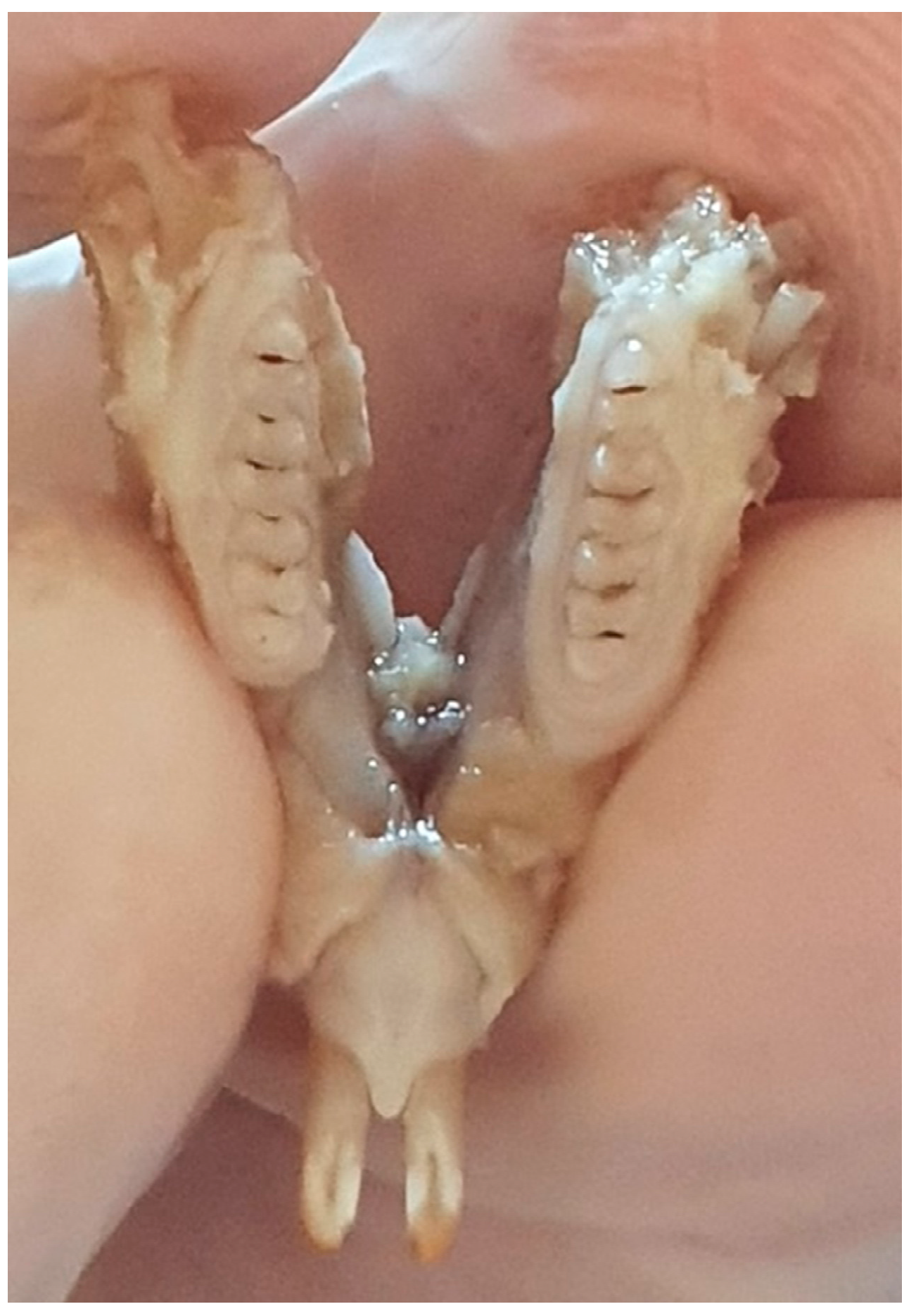
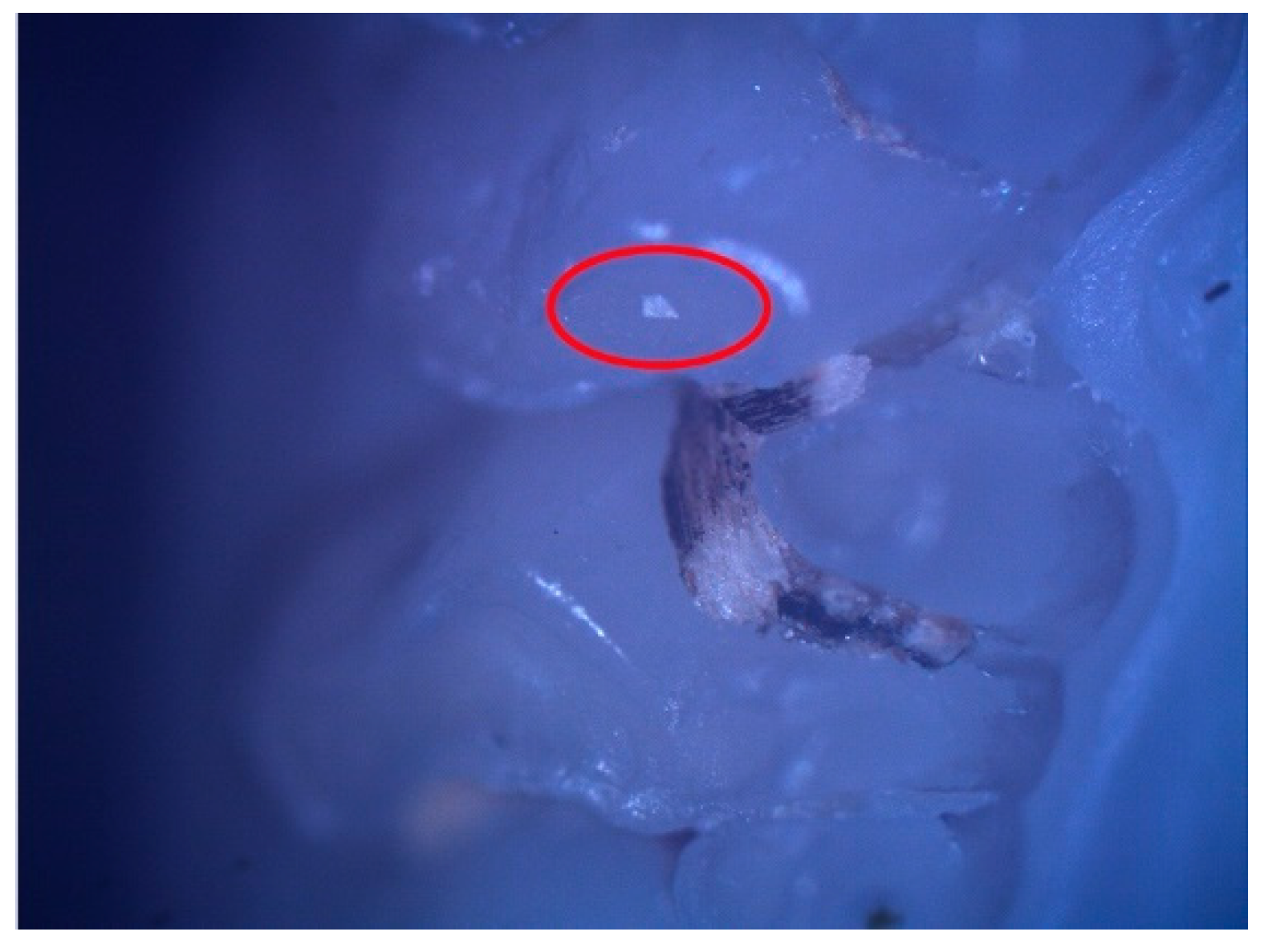
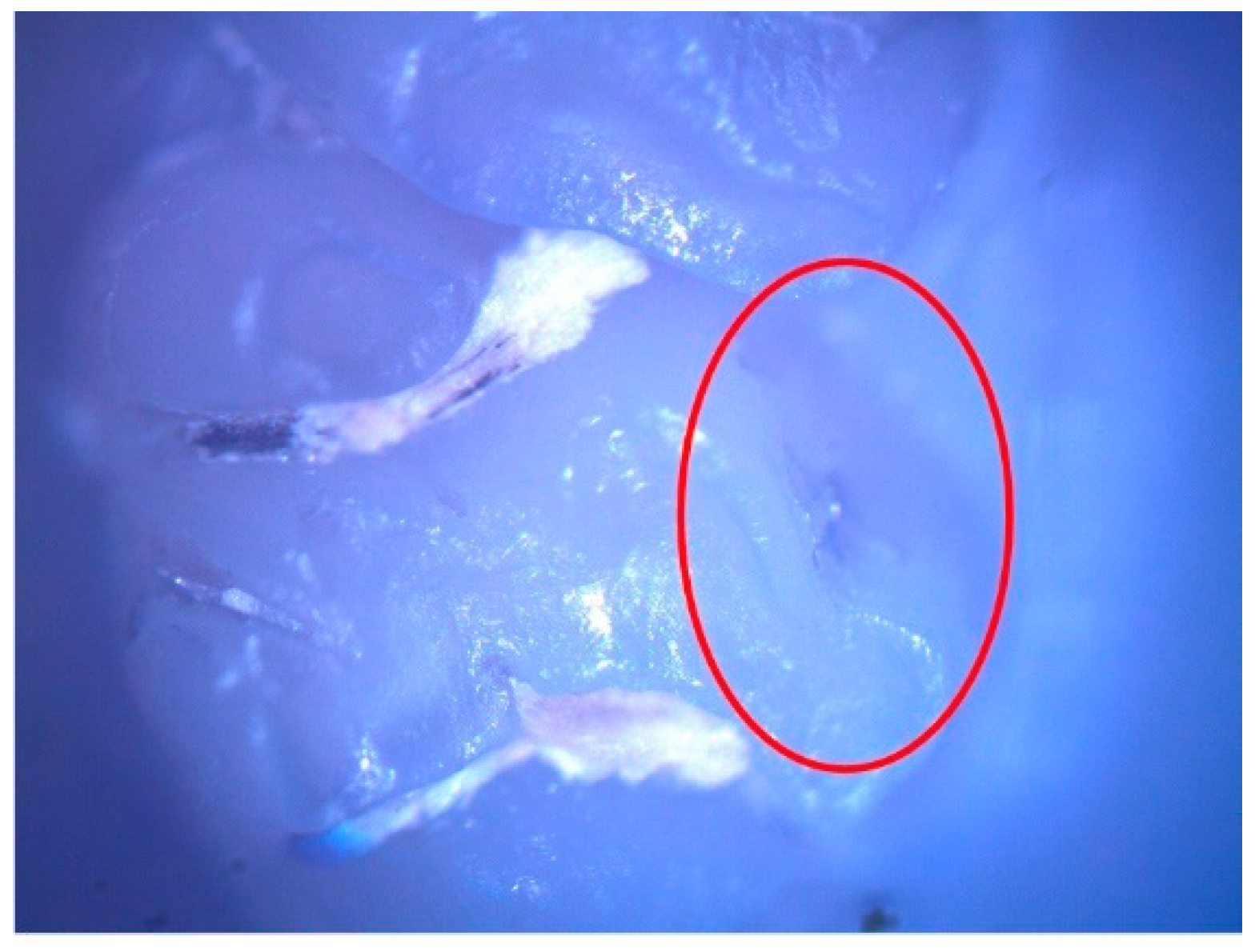

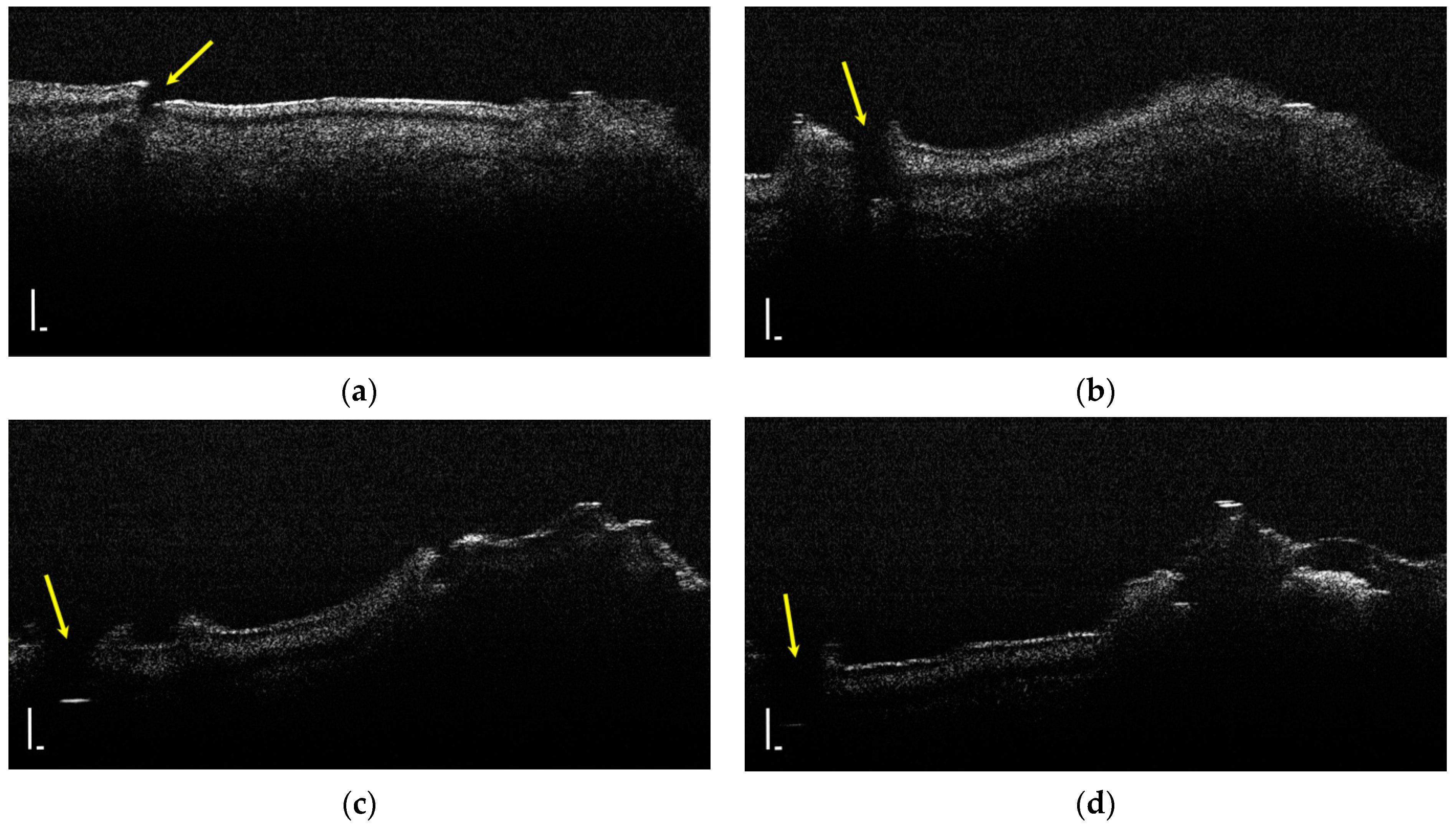
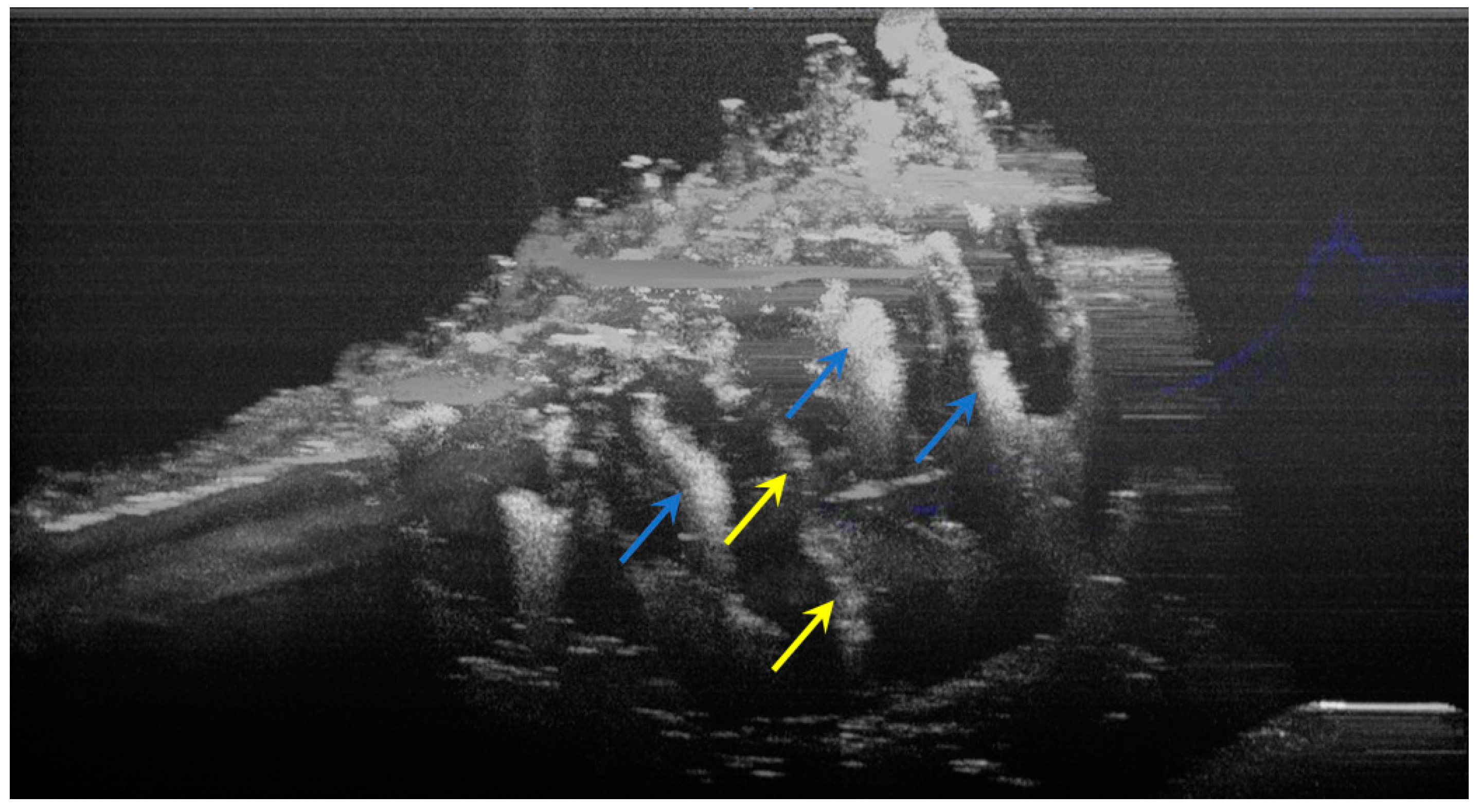

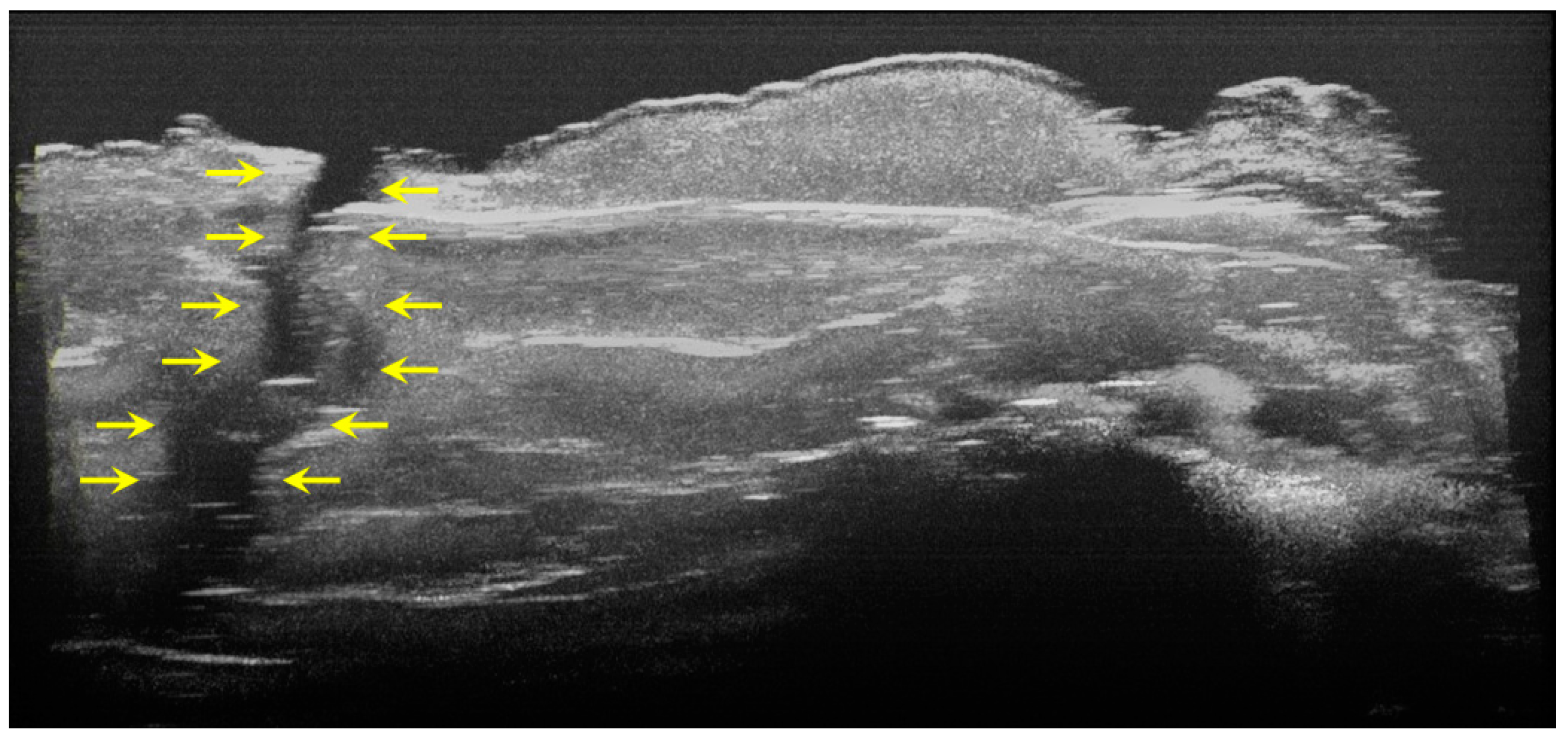

| Rat Pups | ||
|---|---|---|
| with DDE | without DDE | |
| Number of pups | 4 | 11 |
| Number of analyzed teeth | 64 | 484 |
| Number of DDE | 42 | 0 |
| Hypoplasia | 9 | 0 |
| Hypomineralization | 33 | 0 |
Publisher’s Note: MDPI stays neutral with regard to jurisdictional claims in published maps and institutional affiliations. |
© 2022 by the authors. Licensee MDPI, Basel, Switzerland. This article is an open access article distributed under the terms and conditions of the Creative Commons Attribution (CC BY) license (https://creativecommons.org/licenses/by/4.0/).
Share and Cite
Popescu, M.; Scrieciu, M.; Osiac, E.; Bătăiosu, M.; Vlăduțu, D.; Pascu, R.M.; Stănuși, A.; Glodeanu, A.D.; Ionescu, M.; Mercuț, V. Applications of Optical Coherence Tomography in the Diagnosis of Enamel Defects. Diagnostics 2022, 12, 636. https://doi.org/10.3390/diagnostics12030636
Popescu M, Scrieciu M, Osiac E, Bătăiosu M, Vlăduțu D, Pascu RM, Stănuși A, Glodeanu AD, Ionescu M, Mercuț V. Applications of Optical Coherence Tomography in the Diagnosis of Enamel Defects. Diagnostics. 2022; 12(3):636. https://doi.org/10.3390/diagnostics12030636
Chicago/Turabian StylePopescu, Mihai, Monica Scrieciu, Eugen Osiac, Marilena Bătăiosu, Diana Vlăduțu, Roxana Maria Pascu, Andreea Stănuși, Adina Dorina Glodeanu, Mihaela Ionescu, and Veronica Mercuț. 2022. "Applications of Optical Coherence Tomography in the Diagnosis of Enamel Defects" Diagnostics 12, no. 3: 636. https://doi.org/10.3390/diagnostics12030636
APA StylePopescu, M., Scrieciu, M., Osiac, E., Bătăiosu, M., Vlăduțu, D., Pascu, R. M., Stănuși, A., Glodeanu, A. D., Ionescu, M., & Mercuț, V. (2022). Applications of Optical Coherence Tomography in the Diagnosis of Enamel Defects. Diagnostics, 12(3), 636. https://doi.org/10.3390/diagnostics12030636






